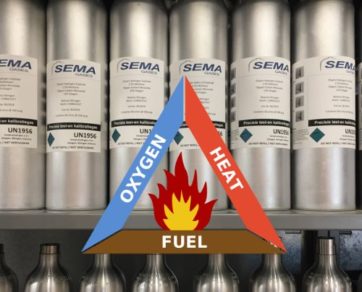updated on 22-07-2021
A Safety Data Sheet (SDS), Material Safety Data Sheet (MSDS) or Product Safety Datasheet (PSDS) is an important component of product stewardship, occupational safety and health, and spill-handling procedures. Safety Data Sheets are a widely used system for cataloguing information on chemicals, chemical compounds, and chemical mixtures. SDS formats can vary from source to source within a country depending on national requirements. SDS information may include instructions for the safe use and potential hazards associated with a particular material or product. The SDS sheet should be available for reference in the area where the chemicals are being stored or in use. There is also a duty to properly label substances by physicochemical, health and environmental risk. Labels can include hazard symbols such as the European Union standard symbols.
European Union
Safety Data Sheets have been made an integral part of the system of Regulation (EC) No 1907/2006 (REACH). The original requirements of REACH for SDS sheets have been further adapted to take into account the rules for Safety Data Sheets of the Global Harmonized System (GHS). The implementation of other elements of the GHS into EU legislation that were introduced by Regulation (EC) No 1272/2008 (CLP) via an update to Annex II of REACH. The SDS sheet follows a 16 section format which is internationally agreed and for substances especially, the SDS sheet should be followed with an Annex that contains the exposure scenarios of this particular substance. The SDS sheet must be supplied in an official language of the Member State(s) where the substance or mixture is placed on the market, unless the Member State(s) concerned provide(s) otherwise (Article 31 (5) of REACH).
What are the 16 sections of a Safety Data Sheet?
SECTION 1: Identification of the substance/mixture and the company/undertaking
• Product identifier
• 1.2. Relevant identified uses of the substance or mixture and uses advised against
• 1.3. Details of the supplier of the safety data sheet
• 1.4. Emergency telephone number
SECTION 2: Hazards identification
• 2.1. Classification of the substance or mixture
• 2.2. Label elements
• 2.3. Other hazards
SECTION 3: Composition/information on ingredients
• 3.1. Substances
• 3.2. Mixtures
SECTION 4: First aid measures
• 4.1. Description of first aid measures
• 4.2. Most important symptoms and effects, both acute and delayed
• 4.3. Indication of any immediate medical attention and special treatment needed
SECTION 5: Firefighting measures
• 5.1. Extinguishing media
• 5.2. Special hazards arising from the substance or mixture
• 5.3. Advice for firefighters
SECTION 6: Accidental release measure
• 6.1. Personal precautions, protective equipment and emergency procedures
• 6.2. Environmental precautions
• 6.3. Methods and material for containment and cleaning up
• 6.4. Reference to other sections
SECTION 7: Handling and storage
• 7.1. Precautions for safe handling
• 7.2. Conditions for safe storage, including any incompatibilities
• 7.3. Specific end use(s)
SECTION 8: Exposure controls/personal protection
• 8.1. Control parameters
• 8.2. Exposure controls
SECTION 9: Physical and chemical properties
• 9.1. Information on basic physical and chemical properties
• 9.2. Other information
SECTION 10: Stability and reactivity
• 10.1. Reactivity
• 10.2. Chemical stability
• 10.3. Possibility of hazardous reactions
• 10.4. Conditions to avoid
• 10.5. Incompatible materials
• 10.6. Hazardous decomposition products
SECTION 11: Toxicological information
• 11.1. Information on toxicological effects
SECTION 12: Ecological information
• 12.1. Toxicity
• 12.2. Persistence and degradability
• 12.3. Bioaccumulative potential
• 12.4. Mobility in soil
• 12.5. Results of PBT and vPvB assessment
• 12.6. Other adverse effects
SECTION 13: Disposal Considerations
• 13.1. Waste treatment methods
SECTION 14: Transport information
• 14.1. UN number
• 14.2. UN proper shipping name
• 14.3. Transport hazard class(es)
• 14.4. Packing group
• 14.5. Environmental hazards
• 14.6. Special precautions for user
• 14.7. Transport in bulk according to Annex II of MARPOL73/78 and the IBC Code
SECTION 15: Regulatory information
• 15.1. Safety, health and environmental regulations/legislation specific for the substance or mixture
• 15.2. Chemical safety assessment
SECTION 16: Other information
The Netherlands
Dutch Safety Data Sheets are well known as Veiligheidsinformatieblad or Chemiekaarten. This naming is a collection of Safety Data Sheets of the most widely used chemicals. The Chemiekaarten boek is commercially available, but also made available through educational institutes, such as the website offered by the University of Groningen.
United Kingdom
In the U.K., the Chemicals (Hazard Information and Packaging for Supply) Regulations 2002 – known as CHIP Regulations was revoked on June first and replaced by CLP Regulations. The Control of Substances Hazardous to Health (COSHH) Regulations govern the use of hazardous substances in the workplace in the UK and specifically require an assessment of the use of a substance. Regulation 12 requires that an employer provides employees with information, instruction and training for people exposed to hazardous substances. This duty would be very nearly impossible without the datasheet as a starting point.
It is important for employers, therefore, to insist on receiving a datasheet from a supplier of a substance. The duty to supply information is not confined to informing only business users of products. SDS sheets for retail products sold by large DIY shops are usually obtainable on those companies’ websites. Websites of manufacturers and large suppliers do not always include them even if the information is obtainable from retailers but written or telephone requests for paper copies will usually be responded to favourably.
United Nations
The United Nations (UN) defines certain details used in SDS sheets such as the UN numbers used to identify some hazardous materials in a standard form while in international transit.
United States
In the U.S., the Occupational Safety and Health Administration requires that SDS sheets be available to employees for potentially harmful substances handled in the workplace under the Hazard Communication regulation. The SDS is also required to be made available to local fire departments and local and state emergency planning officials under Section 311 of the Emergency Planning and Community Right-to-Know Act. The American Chemical Society defines Chemical Abstracts Service Registry Numbers (CAS numbers) which provide a unique number for each chemical and are also used internationally in SDS sheets. Reviews of MSDS sheets by the U.S. Chemical Safety and Hazard Investigation Board have detected dangerous deficiencies.
The board’s Combustible Dust Hazard Study analysed 140 datasheets of substances capable of producing combustible dusts. None of the MSDS sheets contained all the information the board said was needed to work with the material safely, and 41% failed even to mention that the substance was combustible. As part of its study of an explosion and fire that destroyed the Barton Solvents facility in Valley Center, Kansas, in 2007, the safety board reviewed 62 MSDS sheets for commonly used nonconductive flammable liquids. As in the combustible dust study, the board found all the data sheets inadequate.
In 2012, the US adopted the 16 section Safety Data Sheet to replace Material Safety Data Sheets. This entered into force on December 1, 2013. These new Safety Data Sheets comply with the Globally Harmonized System of Classification and Labelling of Chemicals (GHS). By June 1, 2015, employers were required to have their workplace labelling and hazard communication programs updated as necessary, including all MSDS sheets replaced with SDS-formatted documents.
SEMA Gases provides a free platform for downloading all our available Safety Data Sheet (SDS), Material Safety Data Sheet (MSDS) or Product Safety Data Sheet (PSDS) here.



